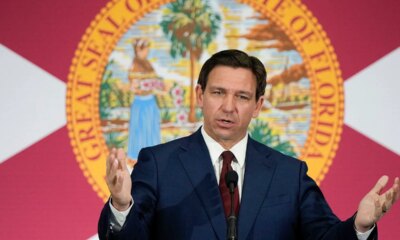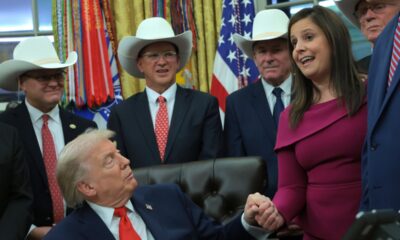Finance
Trump win has economists concerned US economy will fail to make soft landing

Investors this year have grown increasingly confident the US economy will achieve a “soft landing.”
But the election of Donald Trump as the nation’s next president has complicated the outlook.
And some economists now think it’s likely the US could face another inflation resurgence if Trump follows through with his key campaign promises.
“We are in the soft landing,” Nobel prize-winning economist and Columbia University professor Joseph Stiglitz said at Yahoo Finance’s annual Invest conference on Tuesday. “But that ends Jan. 20.”
Trump and his proposed policies have been viewed as potentially more inflationary due to the president-elect’s campaign promises of high tariffs on imported goods, tax cuts for corporations, and curbs on immigration. Those policies could also pressure an already bloated federal deficit, further complicating the Federal Reserve’s path forward for interest rates.
“The biggest risk is a large across-the-board tariff, which would likely hit growth hard,” Jan Hatzius, chief economist at Goldman Sachs, wrote in a note to clients on Thursday.
Jennifer McKeown, chief global economist at Capital Economics, also acknowledged in a note this week there are “upside risks” to inflation “stemming partly from Trump’s proposed tariff and immigration policies.”
And investors have taken notice.
On Wednesday, the latest Global Fund Manager Survey from Bank of America highlighted increased expectations of a “no landing” scenario, in which the economy continues to grow but inflation pressures persist, leading to a higher-for-longer interest rate policy from the central bank.
Tariffs have been one of the most talked-about promises of Trump’s campaign. The president-elect has pledged to impose blanket tariffs of at least 10% on all trading partners, including a 60% tariff on Chinese imports.
“It will be inflationary,” Stiglitz said. “And then you start thinking of the inflationary spiral. The prices go up. Workers will want more wages. And then you start thinking of what happens if others retaliate [with their own duties.]”
Minneapolis Fed president Neel Kashkari categorized a possible retaliation as a “tit-for-tat” trade war, which would keep inflation elevated over the long term.
“If inflation goes up, [Federal Reserve Chair Jerome Powell] is going to raise interest rates,” Stiglitz said.
“You combine the higher interest rates and the retaliation from other countries, you’re going to get a global slowdown. Then you have the worst of all possible worlds: inflation and stagnation, or slow growth.”

Finance
Bank of Korea needs to remain wary of financial stability risks, board member says

SEOUL, Dec 23 (Reuters) – South Korea’s central bank needs to remain wary of financial stability risks, such as heightened volatility in the won currency and upward pressure on house prices, a board member said on Tuesday.
“Volatility is increasing in financial and foreign exchange markets with sharp fluctuations in stock prices and comparative weakness in the won,” said Chang Yong-sung, a member of the Bank of Korea’s seven-seat monetary policy board.
Sign up here.
The won hit on Tuesday its weakest level since early April at 1,483.5 per dollar. It has fallen more than 8% in the second half of 2025.
Chang also warned of high credit risks for some vulnerable sectors and continuously rising house prices in his comments released with the central bank’s semiannual financial stability report.
In the report, the BOK said it would monitor risk factors within the financial system and proactively seek market stabilising measures if needed, though it noted most indicators of foreign exchange conditions remained stable.
Monetary policy would continue to be coordinated with macroprudential policies, it added.
The BOK’s next monetary policy meeting is in January.
Reporting by Jihoon Lee; Editing by Jamie Freed
Our Standards: The Thomson Reuters Trust Principles.
Finance
Mike Burkhold: A Blueprint for South Carolina’s Financial Future – FITSNews

“I am running because the system needs to be fixed and I have the skills and mindset to do it…”
by MIKE BURKHOLD
***
Earlier this month, at the invitation of Virginia Secretary of Finance Steve Cummings, I spent a full day in Richmond meeting with leaders from across that state’s financial infrastructure. These were not ceremonial handshakes. These were working meetings — substantive, focused and highly instructive.
I met with teams overseeing budgeting, taxation, regulatory oversight, accounting and administration. What I found was a modern, integrated and disciplined approach to managing public money. And it made me even more certain of one thing: South Carolina is ready for change.
***
TEAMWORK AND TALENT MATTER
What stood out most in Virginia was the cohesion. From top to bottom, everyone I met shared the same mission — being responsible stewards of the taxpayers’ money. No silos. No blame games. Just a united focus on efficiency, transparency and performance.
That mindset doesn’t happen by accident. It is baked into the culture. The Secretary of Finance meets quarterly with department heads to review budgets, resolve audit findings and keep teams on track. There is accountability at every level. And it works.
That is what I want to bring to South Carolina. As Comptroller General, my job is to revitalize and modernize a critical finance function and to do it in close partnership with the legislature, the governor and the treasurer. I want to build an office that operates with precision, earns trust and gives lawmakers the clarity they need to govern wisely.
***
THIS IS BIGGER THAN ONE SEAT
I am not running for this office because I want a long political career. I am running because the system needs to be fixed and I have the skills and mindset to do it.
If part of that fix means rethinking whether this seat should remain an elected position then I welcome that conversation. In other states like Florida, voters elect a Chief Financial Officer with broad oversight. In Virginia, the Secretary of Finance is appointed by the governor and oversees all fiscal functions. Either model can work – but both reflect a commitment to modern coordinated financial management.
What matters most is that we have a structure that delivers results and earns the public’s trust. That structure needs to be part of a bigger conversation focused on delivering value to citizens – not maintaining fiefdoms or political turf.
***
RELATED | S.C. ‘REPUBLICANS’ REBUFF TRUMP ON REDISTRICTING
***
PUBLIC SERVICE STARTS WITH LEADERSHIP
One of the most inspiring parts of my trip was seeing the caliber of leaders who had left high-paying private sector roles to serve the people of Virginia. They brought with them a culture of excellence and a belief that good government is possible when the right people step forward.
We have that kind of talent in South Carolina. We just need to encourage more of it. I am stepping up because I believe in servant leadership. I see a seat that has not been led this way in a long time and there is a lot to fix. Not just the systems and operations but also the teamwork and coordination across agencies.
My goal is not what is best for Mike. It is what is best for South Carolina. I want to rebuild the Comptroller General’s office into a trusted partner, a respected institution and a model for modern financial leadership. Then I want to help figure out what structure will best serve the next generation.
***
A MOMENT OF OPPORTUNITY
The recent $3.5 billion error exposed just how outdated and fragile our current systems are. But we are not starting from scratch. We are starting from a place of strength. We have smart people, a strong economy and the will to do better.
Now we need to modernize our expectations. We need to align talent. We need to redesign the systems that manage $40 billion of taxpayer money. And we need leadership that sees the big picture, listens well and gets the details right.
South Carolina’s future is full of promise. But to get there, we need to treat government finance with the same rigor, discipline and urgency as any top-performing business.
That is why I am running. Not to keep a seat – but to serve the mission.
***
ABOUT THE AUTHOR…

Mike Burkhold is a Republican candidate for comptroller general of South Carolina.
***
WANNA SOUND OFF?
Got something you’d like to say in response to one of our articles? Or an issue you’d like to address proactively? We have an open microphone policy! Submit your letter to the editor (or guest column) via email HERE. Got a tip for a story? CLICK HERE. Got a technical question or a glitch to report? CLICK HERE.
Finance
Why investing in a Trump Account could complicate your taxes

Parents who put money into their children’s “Trump Accounts” might face a headache come tax time: Even the smallest contributions may require them to fill out a little-used gift tax form that can take hours to complete.
Several tax experts have raised concerns about the new savings vehicles, which were created in Republicans’ massive tax and spending bill this summer, and have urged Congress to pass a new law so that families who use it won’t have to file gift tax returns.
“It’s going to create a compliance nightmare,” said Amber Waldman, senior director for estate and gift tax for RSM US, a tax and consulting firm.
Under the terms of the One Big Beautiful Bill law that created it, the federal government will seed each Trump Account with $1,000 for every U.S. citizen born from 2025 through 2028. Much like an individual retirement account, the money will be invested in funds that track the stock market. The idea is that children’s growing pot of money will eventually help them pay for education or a home purchase when they become adults.
Parents, relatives, employers and nonprofits also can contribute to the accounts. Businessman Michael Dell and his wife Susan have pledged to put $250 in each of the accounts of 25 million children who are younger than 10 today.
But some tax experts think lawmakers overlooked a tax requirement that could make the accounts too burdensome for most parents.
A contribution to a child’s Trump Account is a taxable gift, which requires the giver to fill out one of the IRS’s more complicated tax forms, Form 709. The 10-page document takes the average filer or their accountant more than six hours to complete, and the government has only accepted mailed submissions; that changes this coming tax season, when e-filing will become available.
It’s used by fewer than 225,000 households a year, federal data show, and is so obscure that commercial tax software like TurboTax doesn’t include it.
“If you want to apply for the $1,000 because your kid was born within the time period, fine. If your employer wants to make a contribution or you qualify for a contribution from a charitable organization … fine. But don’t put your own money in until this is clarified,” said Susan Bart, a lawyer who specializes in estate and gift tax.
Most gifts aren’t nearly this complicated. Under long-standing law, most people can give cash gifts to one another tax-free. But if it’s a sizable amount – more than $19,000 – the IRS requires the donor to file Form 709. Over time, if those gifts add up to more than $15 million in the giver’s lifetime, they need to pay certain taxes. The whole system is meant to prevent very wealthy people from doling out large cash gifts during their lifetimes so their heirs can avoid estate taxes later.
But because there’s no provision for contributions to Trump Accounts to count as exempt gifts under current tax law, donors would have to declare every contribution, several tax experts say. This applies whether the donation is $25 or as much as the $5,000 annual cap. That’s because to be considered a tax-exempt gift, the recipient has to be able to access the money right away. Trump Account beneficiaries cannot withdraw the money until they turn 18.
Asked whether Trump Account contributions are required to be reported, an IRS spokesman referred questions to the Treasury Department, where several officials did not answer questions from The Washington Post.
The American College of Trust and Estate Counsel, a lawyers group, sent a letter raising the issue to the congressional tax-writing committees last month. The group’s Washington affairs chair Kevin Matz said his group received no answer beyond acknowledgment that the letter was received.
Congress has dealt with a problem like this before. Lawmakers approved a clause exempting 529 accounts – the tax-advantaged savings accounts for a child’s education – from the requirement that the recipient have present use of the gift. That means parents, grandparents and others can put money in 529 accounts without filing gift tax returns.
The experts who raised the issue are calling on Congress to make the same legislative fix for Trump Accounts.
“It seems like legislators accidentally left that out,” Waldman said.
The 10-page tax form asks a series of questions that are nearly indecipherable to the uninitiated. It distinguishes gifts that are “generation-skipping” – such as a grandparent giving money to a grandchild. When a married couple makes a gift, it probes whether the amount can legally be considered split between them, or attributable to just one.
Even experts scratch their heads. “Not all accountants necessarily have the experience and background to be able to complete it without extensive study,” Matz said.
Bart agreed: “It’s not a DIY form by any means.”
She said she’s seen lawyers befuddled by Form 709 before. “Sometimes my partners in other practice areas who are very, very smart people, they think: I can do this for my own kid or grandchild. They come running back after they look at the form a while. You need to be a specialized attorney with a lot of experience in the area.”
Many people might contribute to Trump Accounts without knowing that they are supposed to file Form 709, and aren’t likely to file it. But experts believe that skipping the form could create problems for the parents if they’re ever audited. Or if tax software like TurboTax starts including Trump Account questions, the taxpayer might not be able to submit their returns through the software if they indicate that they gave to the accounts.
Parents can still create Trump Accounts for their children to receive money from the government and charities like Dell’s without triggering the tax form problem.
“Of course if the government’s giving you a free $1,000, go ahead and take it. That’s not going to hurt you,” Waldman said. “If you’re thinking about personally contributing, consider your other options.”
Even without the tax-filing complications, Trump Accounts might not be the best way for most parents to save money for their children, experts say. The 529 plans offer much better tax benefits – unlike Trump Accounts, parents can often take some state tax deductions when they put money into the account, and if the child uses the money to pay for education, the earnings inside the account are never taxed.
If parents want a multipurpose savings vehicle for their kids that is not just limited to education spending, an ordinary taxable brokerage account might also be a better choice, tax professionals say. Trump Accounts are untaxed during the beneficiary’s childhood, when the money is growing in the account, unlike a brokerage account that could require paying taxes on any dividends. But the tax treatment when the child does withdraw the money could be much more favorable on the brokerage account – that money gets the lower capital gains tax rate, while Trump Account withdrawals are taxed at the same rate as ordinary income, and even come with a 10 percent tax penalty if the child doesn’t use the money for a qualified purpose. And the brokerage account offers a much wider range of investment options.
“As a tax-advantaged account, it’s a terrible tax-advantaged account,” said Greg Leierson, senior fellow at New York University’s Tax Law Center.
-

 Iowa1 week ago
Iowa1 week agoAddy Brown motivated to step up in Audi Crooks’ absence vs. UNI
-

 Iowa1 week ago
Iowa1 week agoHow much snow did Iowa get? See Iowa’s latest snowfall totals
-

 Maine7 days ago
Maine7 days agoElementary-aged student killed in school bus crash in southern Maine
-

 Maryland1 week ago
Maryland1 week agoFrigid temperatures to start the week in Maryland
-

 New Mexico6 days ago
New Mexico6 days agoFamily clarifies why they believe missing New Mexico man is dead
-

 South Dakota1 week ago
South Dakota1 week agoNature: Snow in South Dakota
-

 Detroit, MI1 week ago
Detroit, MI1 week ago‘Love being a pedo’: Metro Detroit doctor, attorney, therapist accused in web of child porn chats
-

 Health1 week ago
Health1 week ago‘Aggressive’ new flu variant sweeps globe as doctors warn of severe symptoms























